Link to video: https://youtu.be/a1y2Zh2_fgk
Ephemeral City: Man Wah Complex, Jordan
The street, as ordinary as a form of infrastructure as it is, it is heavily linked to our lives. Walking through the city, one might fail to notice the moments on the street. However, if one pays attention, things will start to appear and with the camera, these ephemeral moments on the street can be captured and preserved. With a camera, one becomes an observer, looking at the play unfolding in front of their eyes. The video essay thus aims to bring out some of that extraordinary from the ordinary.
Literature review The Man Wah Sun Chuen, is a private housing estate located in Jordan, near the former Jordan Road Ferry Pier, now Austin MTR station.
 Man Wah Sun Chuen (1976), Wikipedia
Man Wah Sun Chuen (1976), Wikipedia
Through the years, with land reclamation projects being carried out, the complex now sits further in land and the demographic living within the complex has shifted to be more middle class. The old buildings within the complex have projected this perception of a dilapidated neighbourhood. However, walking through the streets in the complex, one gets the image of an integrated neighbourhood where everybody knows each other and their dedication to their jobs. Walking around, one is able to see shop owners getting their shop ready for business, some might be making small repairs to their door or even just talking with each other. The intervention of the camera then provides a view into that world, untouched and uncompromised. As the tool that can truly stop time, the camera also serves the function of documenting that period of history. To bring out the lives of the people living there and make them known to others.
Zooming into the street level inside the estate, the flow of the people has created a lively community between the shop owners, residents and passers-by. Many of these interactions might seem unrelated on the surface, but through photography, one has the ability to form relationships between different subjects. Walking around the estate, the implied relationships start to form when looked closely at. Viewing through the camera, the street becomes a stage and the positioning of the people becomes a form of blocking like in a play. The people in the frame serve the purpose of acting out the space that is captured. As the photograph is two dimensional, the people in it create the space. The atmosphere of the street is also a result of the way the apartments are built. Regulations were laid in place during the 50s which dictated that high rises should have features built-in which allowed for sunlight to penetrate into the ground level. In 1956, building setbacks were regulated to be at an angle of 76 degrees to a low for natural lighting into the streets.
 Buildings Ordinance 1935, Shaping the City with an Intangible Hand
Buildings Ordinance 1935, Shaping the City with an Intangible Hand
Today, that feature is crucial to the people utilizing the space. The influx of natural lighting has given the old estate a new breath of life as the space on the ground are exposed. It allows regular viewers to be aware of the life that exists in that area and to be aware is really important as put by Mary Ellen Mark. Photography has that ability to convey messages to viewers and is able to tell stories on the lives of people.
Methodology The idea of the video came from street photography documentaries in which the photos would be the focus, which is ironic to see stills being prioritised over video. The film starts by moving into the complex from the bridge connecting to the MTR station.
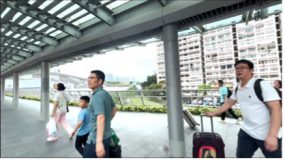
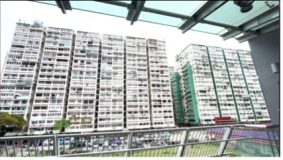 Opening scene from video
Opening scene from video
Once within the complex, still camera footage is utilised to capture the daily moments within the area. The camera was placed mostly at intersections between the streets passing through the complex as most of the movement was concentrated in that area. However, the video taken was intentionally meant to be simplistic as the focus of the film was to be on the photographs presented.
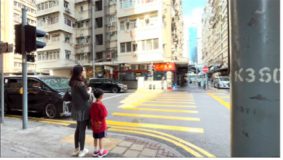
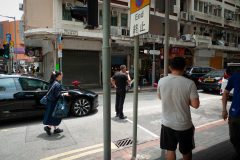
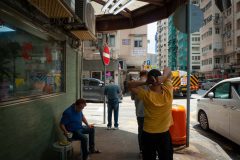
Clip 3 from video Photo 16 Photo 2
The parts of the video are mixed in with photographs taken from the site meant as a way to capture the moments of the life living there. Many of the photos, are of the people living and working within the area. The photographs shown in the video were taken over the course of two days. The presentation style took inspiration from street photography videos in which the photographer would showcase parts of the area in video and cut in photos taken. The still photographs shown are layered over the video, as a result, the sounds from the street are still present as the viewer gets to see the photos. This was done intentionally as a metaphor for how time is constantly moving and thus emphasizes the role of photography in stopping time.
The title cards and ending were inspired by Woody Allen films as they provided a calm and simplistic introduction to the video.

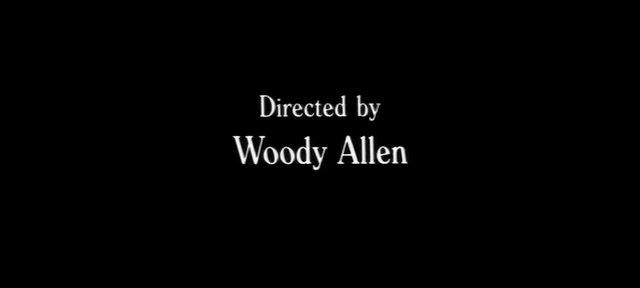
Midnight in Paris, Woody Allen Midnight in Paris, Woody Allen
The ending text was inspired by the ending from In the Mood for Love by Wong Kar Wai. It was done in a way to make the viewer aware of the current situation of the site and hopefully emphasize the role of photography as a way to preserve moments.
 In the Mood for Love, Wong Kar Wai
In the Mood for Love, Wong Kar Wai
Conclusion To conclude, the area around the Man Wah Estate has gone through big changes since its construction in the sixties. The life on the ground level is vibrant and lively despite the estate’s age. As the estate is scheduled to be demolished in the near future, it is sad to see all that life being swept away. This is where photography comes into play as a way for documenting the life in the area. Being the tool that can really stop time, the camera has this powerful role to capture and preserve the moments, turning ordinary into extraordinary.
Tan Yu Hahn 3036181769
Bibliography
Lin, E. (2023, July 7). Hong Kong’s crumbling old flat tenants left in the lurch as developers and authorities go slow during property downturn. South China Morning Post. https://www.scmp.com/news/hong-kong/society/article/3233633/hong-kong-urban-renewal-authoritys-hk35-billion-deficit-revives-calls-revise-compensation-old-flats
28Hse.com. Man Wah Building. https://www.28hse.com/en/estate/detail/man-wah-building-2826
Wikipedia. Man Wah Sun Chuen. Retrieved April 12, 2023, from https://en.wikipedia.org/wiki/Man_Wah_Sun_Chuen
Wilderness. The Importance of Photography for Conservation. https://www.wildernessdestinations.com/journal/photography/the-importance-of-photography-for-conservation
de Certeau, M. (2002). The Practices of Everyday Life. University of California Press.
Zou, H. & Xue, C. Q. L. (2013). Shaping the City with an Intangible Hand-A Review of the Building Control System in Hong Kong. ResearchGate.
Lau, S. S. Y. & Zhang, Q. (2015). Genesis of a Vertical City in Hong Kong. International Journal of High-Rise Buildings, 4(2), 117-125.
Everybody Street, 2013, Cheryl Dunn
Midnight in Paris, 2011, Woody Allen
In The Mood of Love, 2000, Wong Kar Wai
I really love your understanding on photography. I my view, your video successfully captured the space of of Man Wah Complex. I noticed that the clip3 in your video has appeared frequently. In my understanding, you seems want to show the complexity inside the complex. However, I didn’t find the explanation of this shot in your essay. Most of the photos you took are people’s daily life. This made me think how will their life become if Man Wah Complex been dismantled. Although your video didn’t talk about whether this architecture will vanish and how, I think your video has give the audiences an answer: The people are walking, interacting inside this space and inter connected by this space. These actions are resisting the vanish of this place. Although you have a quite pessimistic view on this place so that you start to preserve them using camera, you also brings it’s vitality to those in front of the screen.